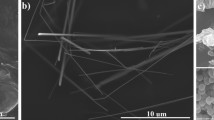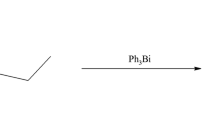Abstract
Multi-walled carbon nanotubes (MWNTs) can be incorporated into conductive polymers to produce superior materials for neural interfaces with high interfacial areas, conductivity and electrochemical stability. This paper explores the addition of MWNTs to polypyrrole (PPy) through two methods, layering and codeposition. Conductivity of PPy doped with polystyrene sulfonate (PSS), a commonly used dopant, was improved by 50% when MWNTs were layered with PPy/PSS. The film electrochemical stability was improved from 38% activity to 66% activity after 400 cycles of oxidation and reduction. Growth inhibition assays indicated that MWNTs are not growth inhibitory. The electroactive polymer-MWNT composites produced demonstrate properties that suggest they are promising candidates for biomedical electrode coatings.



Similar content being viewed by others
References
N.H. Lovell et al., Advances in retinal neuroprosthetics. in Handbook of Neural Engineering, ed. by M. Akay (Wiley-IEEE Press, 2007)
P.J. Rousche, R.A. Normann, Chronic intracortical microstimulation (ICMS) of cat sensory cortex using the Utah intracortical electrode array. IEEE Trans. Rehabil. Eng. (see also IEEE Trans. Neural Syst. Rehabil.) 7(1), 56–68 (1999)
A. Branner et al., Long-term stimulation and recording with a penetrating microelectrode array in cat sciatic nerve. IEEE Trans. Biomed. Eng. 51(1), 146–157 (2004)
X. Cui et al., In vivo studies of polypyrrole/peptide coated neural probes. Biomaterials 24(5), 777–787 (2003)
C.E. Schmidt, V.R. Shastri, J.P. Vacanti, R. Langer, Stimulation of neurite outgrowth using an electrically conducting polymer. Proc. Natl. Acad. Sci. USA 94(17), 8948–8953 (1997)
R.A. Green, L.A. Poole-Warren, N.H. Lovell, Novel Neural Interface for Vision Prosthesis Electrodes: Improving Electrical and Mechanical Properties through Layering, in Proceedings of the 3rd International IEEE EMBS Conference on Neural Engineering, Kohala Coast, Hawaii, USA, 2–5 May 2007, pp. 97–100
X. Cui et al., Surface modification of neural recording electrodes with conducting polymer/biomolecule blends. J. Biomed. Mater. Res. 56(2), 261–272 (2001)
R.T. Richardson et al., The effect of polypyrrole with incorporated neurotrophin-3 on the promotion of neurite outgrowth from auditory neurons. Biomaterials 28(3), 513–523 (2007)
H. Yamato, M. Ohwa, W. Wernet, Stability of polypyrrole and poly(3,4-ethylenedioxythiophene) for biosensor application. J. Electroanal. Chem. 397(1–2), 163–170 (1995)
J.B. Schlenoff, X. Hong, Evolution of physical and electrochemical properties of polypyrrole during extended oxidation. J. Electrochem. Soc. 139(9), 2397–2401 (1992)
F. Beck, P. Braun, M. Oberst, Organic electrochemistry in the solid state-overoxidation of polypyrrole. Phys. Chem. Chem. Phys. 91(9), 967–974 (1987)
X. Zhao et al., Smallest carbon nanotube is 3Å in diameter. Phys. Rev. Lett. 92(12), 125502 (2004)
M.F. Yu et al., Strength and breaking mechanism of multiwalled carbon nanotubes under tensile load. Science 287(5453), 637–664 (2000)
J.P. Salvetat et al., Mechanical properties of carbon nanotubes. Appl. Phys. A 69, 255–260 (1999)
C.M. Williams et al., Electrically conductive polyurethanes for biomedical applications. Biomedical applications of micro- and nanoengineering II. in Proceedings of the SPIE, ed. by D.V. Nicolau, vol. 5651, pp. 329–335 (2005)
D. Liming, H. Pingang, L. Sinan, Functionalized surfaces based on polymers and carbon nanotubes for some biomedical and optoelectronic applications. Nanotechnology 14(10), 1081 (2003)
J. Muller et al., Respiratory toxicity of multi-wall carbon nanotubes. Toxicol. Appl. Pharmacol. 207, 221–231 (2005)
C.-W. Lam et al., Pulmonary toxicity of single-wall carbon nanotubes in mice 7 and 9 days after intratracheal instillation. Toxicol. Sci. 77, 126–134 (2004)
P.J. Borm, W. Kreyling, Toxicological hazards of inhaled nanoparticles-potential implications for drug delivery. J. Nanosci. Nanotechnol. 4, 521–531 (2004)
Author information
Authors and Affiliations
Corresponding author
Rights and permissions
About this article
Cite this article
Green, R.A., Williams, C.M., Lovell, N.H. et al. Novel neural interface for implant electrodes: improving electroactivity of polypyrrole through MWNT incorporation. J Mater Sci: Mater Med 19, 1625–1629 (2008). https://doi.org/10.1007/s10856-008-3376-7
Received:
Accepted:
Published:
Issue Date:
DOI: https://doi.org/10.1007/s10856-008-3376-7




